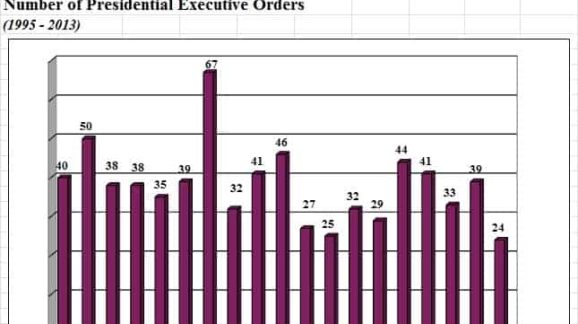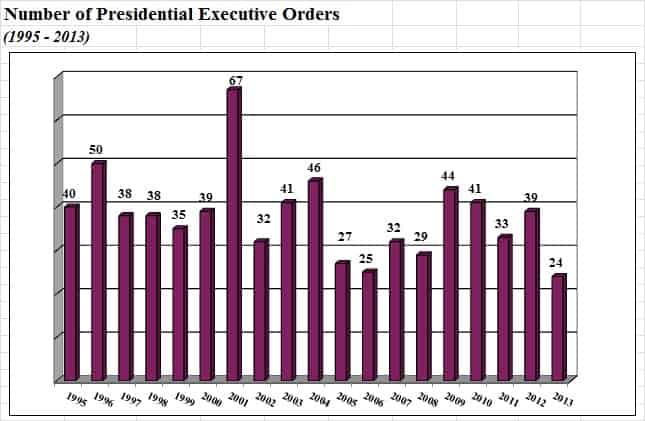Red Tapeworm 2014: A Fourth of July Reflection on Presidental Executive Orders and Loss of Liberty

In other countries, similar edicts may be known as decrees, orders in council, or fiat.
-Wikipedia
This is a special July Fourth Edition of my series Red Tapeworm 2014. It represents Part 15 of a walk through some sections of Ten Thousand Commandments: An Annual Snapshot of the Federal Regulatory State (2014 Edition).
Executive orders covering the internal workings and operations of the federal government do not make up a big component of the Obama “pen” and “phone” initiative (yet), as I’d noted recently in Forbes; “Memos” do instead, as do agency guidance, blog posts and press releases.
Presidential use of executive orders is nothing new. They began with George Washington; they number retroactively to Abraham Lincoln via a 1907 Department of State system.
Obama’s totals are not high compared to other presidents; as of year-end 2013, he had issued 181, as the figure nearby depicting executive orders issued since 1995 shows. Obama did issue more in his first term than President George Bush did in his second term, yet still fewer overall than chief executives did at any other time depicted.

Of course he still has two years to go, and orders such as minimum wage mandate for federal contractors and Non-Retaliation for Disclosure of Compensation Information are big ones. He is primarily using the other instruments noted.
The real question, as economic and social liberty yields in the U.S., is what these executive orders, and those yet to come, are used for; what they do.
Executive orders can liberalize, they can enhance freedom—or they can expand central power. Expansions included Harry Truman’s failed attempt to seize control of America’s steel mills and FDR’s confiscation of gold.
These were “pen” and “phone” undertakings derailing liberty. Yet orders can expand freedoms; Lincoln’s Emancipation Proclamation to free slaves in the rebellious states was a “pen and phone” order in its own right—minus the phone, of course.
Obama’s E.O. 13565 on regulatory review and reform represented a pledge to roll back regulations. The few billion saved was swamped by new rules. In all, four Obama’s executive orders concern over-regulation and rollbacks.
Other executive orders on regulatory restraint were President Bill Clinton’s E.O. 12866. The one that formalized central review of major regulations at the Office of Management and Budget was Ronald Reagan’s E.O. 12291.Clinton’s 12866 was a pullback from the heavier oversight of the Reagan order in that it sought “to reaffirm the primacy of Federal agencies in the regulatory decision-making process.”
The nation existed for many before the first president issued over two dozen executive orders; that was Franklin Pierce, who served 1853-57 (see here and here).
Otherwise, orders numbered fewer than ten and in the teens until Lincoln and the subsequent reconstruction period. The Ulysses S. Grant administration issued a record 217.
From the 20th century onward, orders were to top 100 for each president. They sometimes number in the thousands; FDR issued 3,467 numbered executive orders. (At bottom I’ve pasted executive order counts by administration since the nation’s founding (there is some inexactness involved) and present the total count of 15,177.
(For those interested, executive orders since 1995 by calendar year appear in “Historical Tables Part J: The Unconstitutionality Index” of Ten Thousand Commandments.)
The importance of highlighting executive orders as we celebrate Independence Day is that decrees or fiats issued in a limited government context have profoundly different implications than executive orders in the activist government context that prevails today. Like regulations, orders can have big impacts for or against liberty; and a smaller number of them does not necessarily mean small impacts.
We exist an era in which the private sector increasingly does not set the terms in health care, retirement, education, energy, finance, infrastructure, land and resource management, the funding of science and research and manufacturing. Our economy is many things, but “capitalist” and “laissez faire” are not among its defining characteristics.
Much of what takes place happens with government inappropriately and extra-constitutionally setting national goals and, increasingly, executing normal economic and social interactions. That is not liberty or Independence.
Our mixed economy turned its back on the founders’ constitutional system whereby legislation is created by an elected body. Now, rules and regulations, executive orders, guidance documents, public notices, consent decrees, bulletins, federal press releases and blog posts (and yes, the pen and phone) take on new significance and need vastly more scrutiny from Congress and a too-disengaged public.
A commenter on my Forbes article on Obama’s “Rule by Memo” struck me when he noted that “In his Road to Serfdom, Friedrich A. Hayek predicted that the transference of power to regulatory bodies was inherently totalitarian.”
When more and more activity falls “within government” it doesn’t necessarily require normal Administrative Procedure Act public input thresholds or votes. Increasingly even rules dealing with “internal governmental” operations address what was once the purview of the free economy; they therefore constitute “regulation” not otherwise addressed and should not escape that designation.
The preservation of liberty requires that we safeguard it.
Executive Orders By Adminstration
- George Washington 8
- John Adams 1
- Thomas Jefferson 4
- James Madison 1
- James Monroe 1
- John Quincy Adams 3
- Andrew Jackson 12
- Martin van Buren 10
- William Henry Harrison 0
- John Tyler 17
- James K. Polk 18
- Zachary Taylor 5
- Millard Fillmore 12
- Franklin Pierce 35
- James Buchanan 16
- Abraham Lincoln 48
- Andrew Johnson 79
- Ulysses S. Grant 217
- Rutherford B. Hayes 92
- James Garfield 6
- Chester Arthur 96
- Grover Cleveland – I 113
- Benjamin Harrison 143
- Grover Cleveland – II 140
- William McKinley 185
- Theodore Roosevelt 1,081
- William Howard Taft 724
- Woodrow Wilson 1,803
- Warren G. Harding 522
- Calvin Coolidge 1,203
- Herbert Hoover 996
- Franklin D. Roosevelt 3,467
- Harry S. Truman 894
- Dwight D. Eisenhower 482
- John F. Kennedy 214
- Lyndon B. Johnson 324
- Richard Nixon 346
- Gerald R. Ford 169
- Jimmy Carter 320
- Ronald Reagan 381
- George Bush 166
- William J. Clinton 364
- George W. Bush 291
- Barack Obama 168
Total Number of E.O.s: 15,177, as of year-end 2013. In 2014 so far, President Barack Obama has issued 15.
Source: Author tabulations based upon Executive Orders Disposition Tables Index, Office of the Federal Register, National Archives.; and Executive Orders. The American Presidency Project. Ed. John T. Woolley and Gerhard Peters. Santa Barbara, CA. 1999-2014.
Red Tapeworm 2014 Series:
- Part 1: Guess Which Is the Largest Government on Earth?
- Part 2: Tardy Bureaucrats Gone Wild
- Part 3: Reckoning the Dollar Cost of Federal Regulation
- Part 4: Regulations Catching Up to Government Spending?
- Part 5: Regulations Cost More than Federal Income Taxes
- Part 6: The Federal Government “Eats” 31 Percent Of The U.S. Economy
- Part 7: U.S. Regulation Compared to the World’s Largest Economies
- Part 8: The High Cost of Overcriminalization
- Part 9: Thousands of Federal Register Pages
- Part 10: A Record Number of Federal Register Final Rule Pages
- Part 11: Federal Register Pages Per Decade
- Part 12: Number of Proposed and Final Rules In the Federal Register
- Part 13: Cumulative Final Rules in the Federal Register
- Part 14: The Expanding Code of Federal Regulations